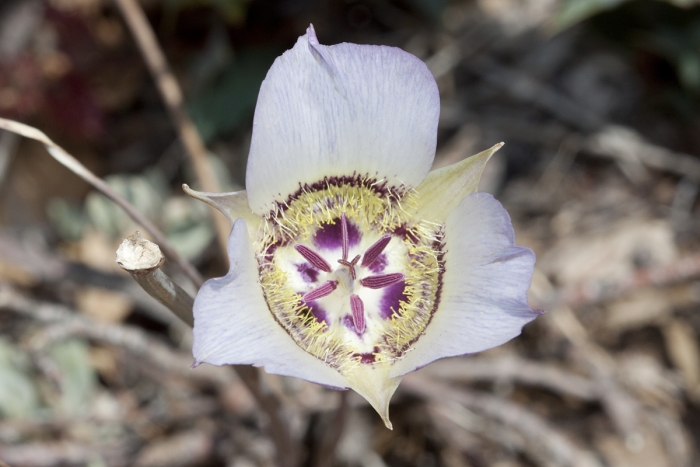Doubting Mariposa Lily
(Calochortus ambiguus)
Doubting Mariposa Lily (Calochortus ambiguus)
/
/

Bill Bouton from San Luis Obispo, CA, USA
CC BY-SA 2.0
Image By:
Bill Bouton from San Luis Obispo, CA, USA
Recorded By:
Copyright:
CC BY-SA 2.0
Copyright Notice:
Photo by: Bill Bouton from San Luis Obispo, CA, USA | License Type: CC BY-SA 2.0 | License URL: https://creativecommons.org/licenses/by-sa/2.0 | Uploader: File Upload Bot (Magnus Manske) | Publisher: Wikimedia Commons | Title: Calochortus_ambiguus_-_Flickr_005.jpg | Notes: User created page with UploadWizard |



































Estimated Native Range
Summary
Calochortus ambiguus, commonly known as Doubting Mariposa Lily, is a deciduous perennial herb native to open grasslands and pine-oak woodlands in the southwestern United States, particularly in Arizona and New Mexico, extending into northern Mexico. It typically grows to a height of 0.2-2 feet (0.06-0.6 meters) and a width of 1-2 feet (0.3-0.6 meters). The plant features grass-like leaves and erect stems, with flowers that are white or very pale lavender, marked by a distinctive green center and reddish-purple anthers. The flowers, which bloom in the spring and summer, are moderately showy and attract pollinators such as bees.
Doubting Mariposa Lily is valued for its drought tolerance and delicate, ornamental flowers, which add a splash of color to rock gardens, native plant gardens, and wildflower meadows. It is best grown in full sun and requires well-drained soils, preferably sandy or rocky, with low water once established. While it is not commonly found in cultivation, it can be a unique addition to a garden with the right conditions. Care should be taken to avoid overwatering, as it can lead to bulb rot. There are no major disease issues, but it can be susceptible to fungal infections if grown in poorly drained soils.CC BY-SA 4.0
Doubting Mariposa Lily is valued for its drought tolerance and delicate, ornamental flowers, which add a splash of color to rock gardens, native plant gardens, and wildflower meadows. It is best grown in full sun and requires well-drained soils, preferably sandy or rocky, with low water once established. While it is not commonly found in cultivation, it can be a unique addition to a garden with the right conditions. Care should be taken to avoid overwatering, as it can lead to bulb rot. There are no major disease issues, but it can be susceptible to fungal infections if grown in poorly drained soils.CC BY-SA 4.0
Plant Description
- Plant Type: Herb
- Height: 0.2-1.7 feet
- Width: 1-1.5 feet
- Growth Rate: Moderate
- Flower Color: Pink, Purple, White
- Flowering Season: Spring, Summer
- Leaf Retention: Deciduous
Growth Requirements
- Sun: Full Sun
- Water: Low
- Drainage: Fast
Common Uses
Drought Tolerant, Low Maintenance, Potted Plant, Rock Garden, Showy Flowers
Natural Habitat
native to open grasslands and pine-oak woodlands in the southwestern United States, particularly in Arizona and New Mexico, extending into northern Mexico
Other Names
Common Names: Arizona Mariposa Lily
Scientific Names: , Calochortus ambiguus, Calochortus watsonii var. ambiguus,
GBIF Accepted Name: Calochortus ambiguus (M.E.Jones) Ownbey